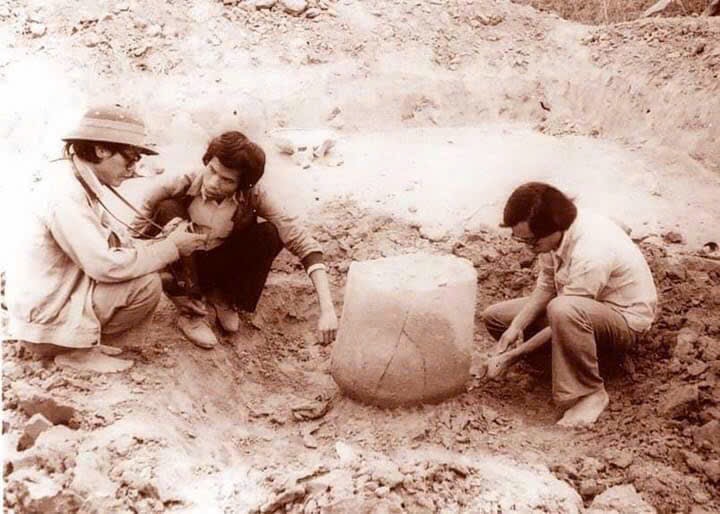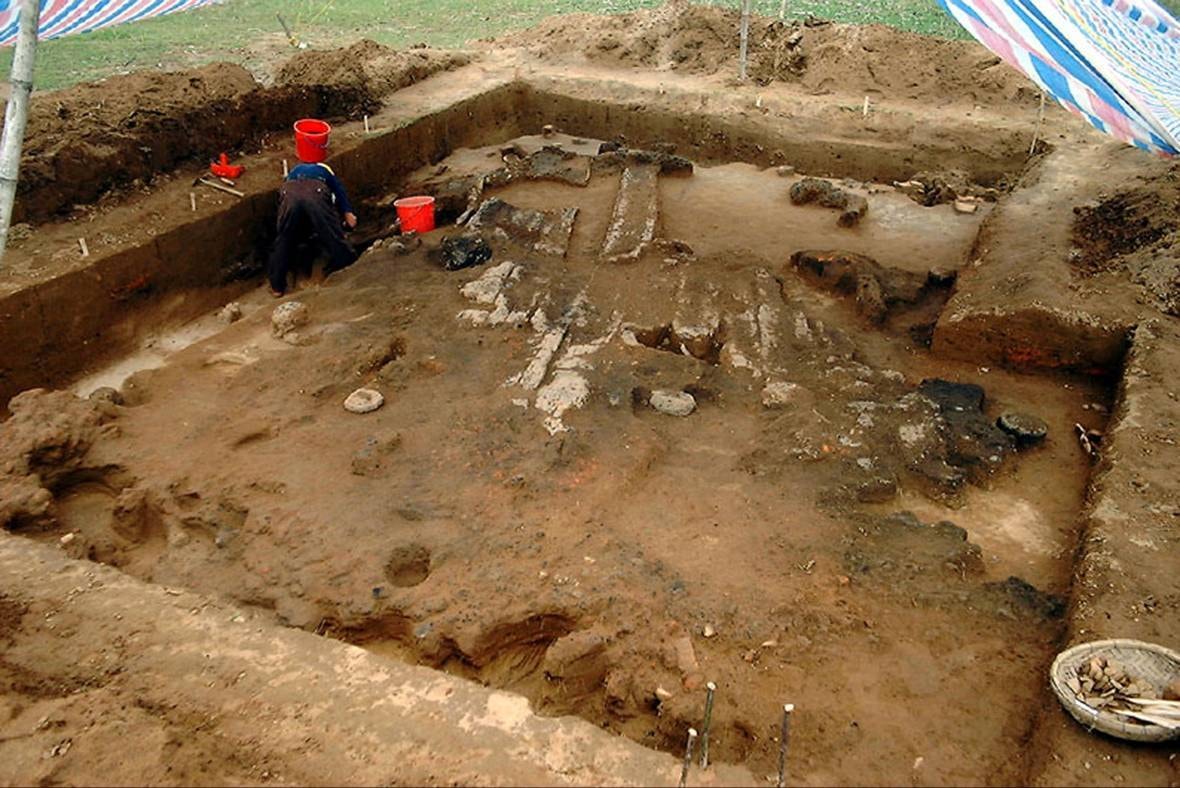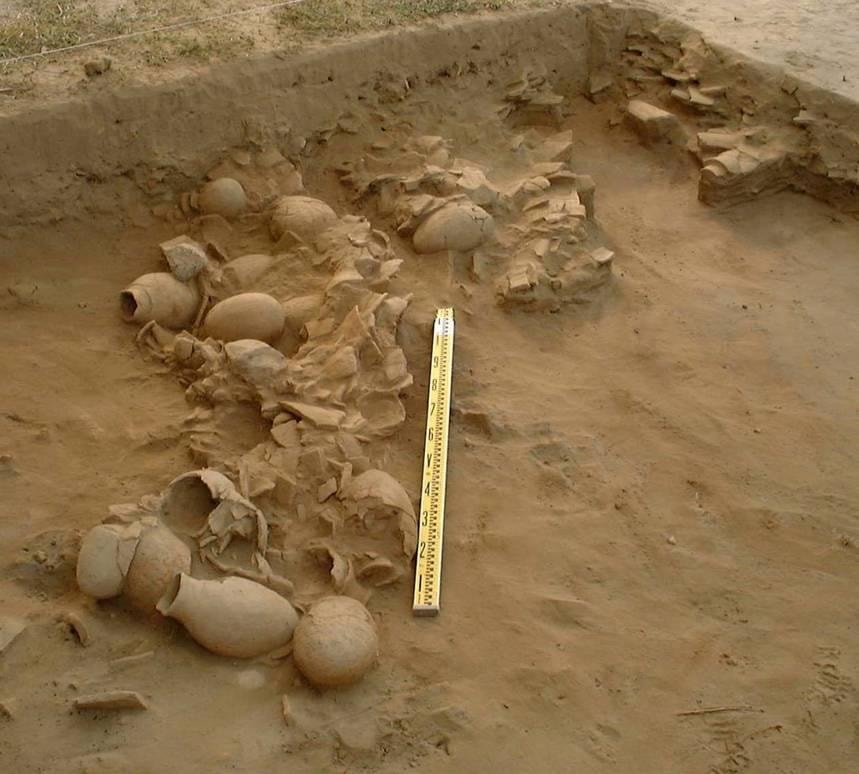
My brothers and I - the archaeologists - were at that time trying to find the past with shovels, hoes and small trowels, gently "revealing" the thousand-year-old marks in each layer of soil...
Special trips
In 1983, we went along the banks of the Tien River (Tien Ha Commune, former Tien Phuoc District). The group included archaeologists, including Mr. Pham Quoc Quan - later a PhD, Director of the Vietnam History Museum and the professional staff of the Quang Nam - Da Nang Provincial Museum.
An excavation led by Mr. Quan with results that experts assessed as more successful than expected. The great discovery here, in addition to the burial area with ceramic coffins called jars belonging to the Sa Huynh culture, also found the site of an earlier habitation of ancient people belonging to the Neolithic period more than 7,000 years ago.
After many years, in 1998, when the province was just separated, Giang district (now Nam Giang) wanted to move the district center to the other side of Ben Giang. A search under the ground of the hills and mounds on the river bank with the place name Ben Giang - the trading and exchange place of the previous centuries called "Salt Road" of the lowland people - Kinh with the mountainous people of Co Tu, was considered necessary.
Also the archaeologists of the National History Museum: Mr. Quang Van Cay, Mr. Ngo The Phong and the professional brothers of the Quang Nam Museum carried out. More than 15 days of digging and searching under the hot summer sun of the midlands. Finally, we also found some jar coffins in the backyard of Mr. Sau's house, next to the road, and also picked up agate beads and stone axes on the riverbank near the water's edge.
Going down the Thu River, just about 1km from the shore on the right bank is the Go Dua burial site. The site also belongs to the Sa Huynh culture about 2,000 years ago, with a fairly high density of jar coffins. In addition to the burial objects and artifacts found from pottery, agate beads, bronze... the newly discovered double jar coffin (two nested inside each other).

I was fortunate to see artifacts from the excavation and later displayed in the Sa Huynh and Champa Culture Museum. In my personal opinion, because the first place to discover the custom of burying people in jars, pots and burial objects was Sa Huynh lagoon, Quang Ngai in 1909, the culture was named. If not, the large-scale Go Dua (Duy Xuyen) site could be used to name the unique ancient culture of the Central region.
And also on the hilly land of Duy Xuyen called Go Cam (or Cam Mau Hoa), near the Chim bridge, the branch of Thu river turning to Ba Ren river, there are very valuable archaeological discoveries that have created new thoughts in studying the history of Quang region, the center of which is Duy Xuyen.
This site was excavated from 1999 to 2002 with the cooperation of local experts, archaeologists in Hanoi , and British and Japanese archaeologists.
These are experts who are quite familiar with the local professional community such as Mr. Nguyen Chieu, Dr. Lam My Dung, Dr. Kim Dung; foreigners include Professor Ian Glover, Dr. Mariko Yamagata. They are people who are often present in the excavation pits of the Sa Huynh culture.
An excavation area of 209m2 discovered a burnt stilt house (wooden columns and floors, bamboo walls plastered with earth, roof tiles) dating back to the late 1st century. But the lower layer is the earlier Sa Huynh culture. At the same time, the Go Cam relic also discovered many egg-shaped vases and bronze arrows.
Also from these discoveries, along with the relics of the downstream of the Thu River that Hoi An excavated many years before with relics also belonging to the Sa Huynh culture such as Hau Xa, An Bang, Thanh Chiem, Xuan An... so now we have a specialized Museum of Sa Huynh Culture in Hoi An.
Gold in every layer of soil
The assessments and comments on the prehistoric periods of Quang Nam from domestic and foreign experts help us understand the past of the land. Artifacts, whether terracotta, glass, stone, bronze, etc., have spoken like echoes thanks to the efforts of research, survey and excavation by archaeologists and local people who love their heritage.

If asked: "Is Dong Son culture found in Quang land?" - then the author of this article would like to confirm that it is.
These are two bronze drums belonging to the Heger II group that were accidentally discovered by the History Department - Hue University of Sciences, during a field trip in 1985 in Axan commune, Hien district (now Tay Giang).
The most obvious is a bronze drum with a very large drum face, over 100cm, found in Khe Lanh Anh, village 1B, Phuoc Tra commune, Hiep Duc. Many burial objects and relics such as knives, arrows, and axes made of bronze originated from Dong Son.
A vast land from sea to mountain, from east to west, from the southwest mountain region is Tra My such as Tran Duong, Mau Long, Nuoc Oa, down to Tien Lanh also discovered and excavated with early Sa Huynh culture. To the west and northwest through Phuoc Son district, Nam Giang to Dong Giang also discovered many similar archaeological sites.
Along with that, Lai Nghi site (Dien Ban commune) was excavated in 2002 - 2004 with expert assessments: "It is one of four sites where gold jewelry was found (the remaining sites are Dai Lanh, Go Mun of Dai Loc district and Go Ma Voi of the old Duy Xuyen district). Gold jewelry is very rarely found in Sa Huynh cultural sites in Vietnam...".
This is the lower reaches of the Thu River, perhaps during the late Sa Huynh period - there were many rich people so many precious jewels were buried with them.
Quang Nam is a fertile land for archaeology. Archaeologists in the past have come here at least once or many times, and certainly will continue to…
Writing this article, I consider it as a stick of incense in memory of those who have passed away: British professor Ian Glover; Dr. Nishimura; Vietnamese archaeologists: Mr. Trinh Can, Quang Van Cay, and Ms. Dr. Kim Dung.
And appreciate the values, the recent discoveries - like Dr. Ha Suong who is working at Quang Nam Museum has made discoveries about Sa Huynh culture, Champa culture, and the project to create information maps about archaeological sites in Da Nang city today.
Source: https://baodanang.vn/hoi-uc-tu-nhung-buoc-chan-3301178.html

















































































































Comment (0)